The City of Portland wants advisory bike lanes to play a larger role in our roadway design mix. This Thursday (12/1) they’ll host an online open house to answer questions and share information about recent and future installations. It’s a relatively sudden push to make the treatment more prominent after they’ve languished in design guidelines for several years.
Advisory bike lanes were first called for in the Portland Bike Plan for 2030 that was drafted in 2009. PBOT uses the treatment on streets with low to moderate car volumes where they want to create safer space for cycling, but don’t want to take the width required for standard bike lanes. The big difference between “advisory” and standard bike lanes is that people drive over the former, whereas it’s illegal to cross into the latter. The way they work is simple: When no bicycle riders are present, drivers can use the full width of the road (driving into the advisory bike lanes). When bicycle riders are present, drivers must yield to other drivers and only pass the bicycle rider when it is safe to do so.
It’s easy to understand why PBOT likes advisory bike lanes: They are very cheap and easy to install, studies show they improve safety outcomes, and they are a way to create space for biking and walking without asking drivers to give up anything in terms of access or parking. Imagine a relatively narrow, low-speed, low-volume residential street without sidewalks in east or southwest Portland. There’s not enough room to stripe bike lanes and two general purpose lanes, so PBOT can stripe advisory bike lanes that are only in effect if/when a walker or bike rider is present.
While the advantages seem obvious, it’s easy to see why some people don’t like them.

Since this is a new treatment that requires people to think and to share the road, they come with hefty skepticism.
In October, PBOT ran into opposition to a project on NE San Rafael Street in the Russell neighborhood of east Portland. The plan was to install advisory bike lanes as part of a repaving project between NE 111th and NE 148th. But that was before some residents pushed back. According to a project update email from PBOT sent October 20th, “PBOT staff heard concerns from residents, particularly around how the advisory bike lanes would work on NE San Rafael Street between NE 132nd and NE 148th avenues.” As a result of those concerns, PBOT has decided to back off plans for that particular stretch of road.
PBOT has told the Russell Neighborhood Association that they’ll do more evaluations of existing advisory bike lane project and then return in 2023 to re-open the conversation about NE San Rafael Street.
The city should have a lot of data to analyze since they installed advisory lanes in three locations this year. In addition to two sections of San Rafael, there are now advisory bike lanes on NE 43rd between Sandy and Tillamook and NE 53rd over I-84. We shared a closer look at both of those installations back in August.
To further air out concerns and questions about this nascent striping treatment, PBOT will host an online open house this Thursday from 6:00 to 7:00 pm. Check out our calendar for the Zoom registration link and more details.



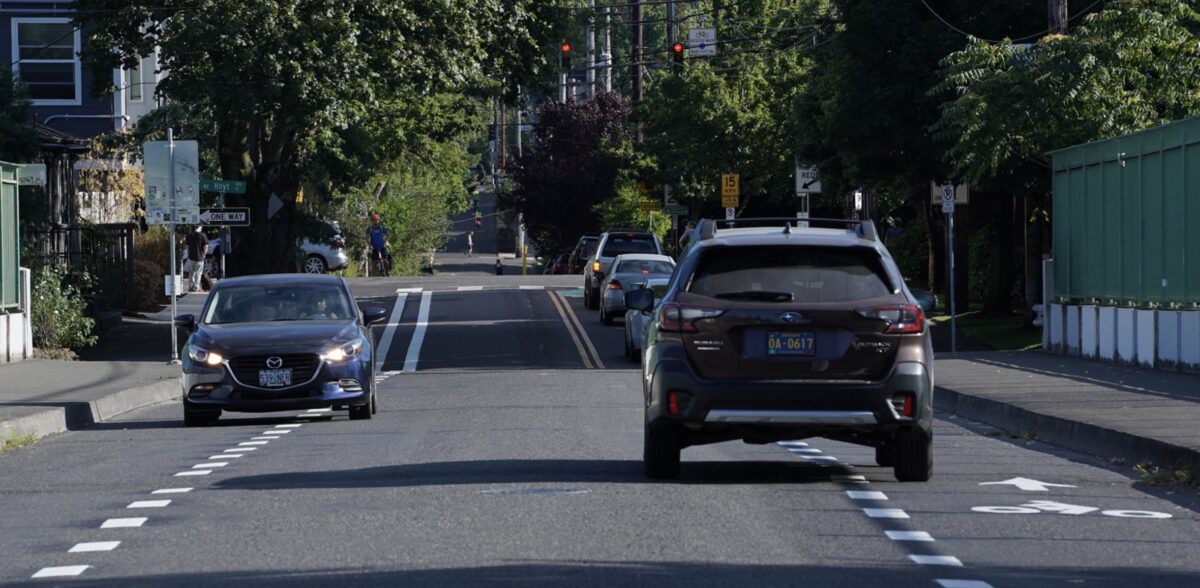
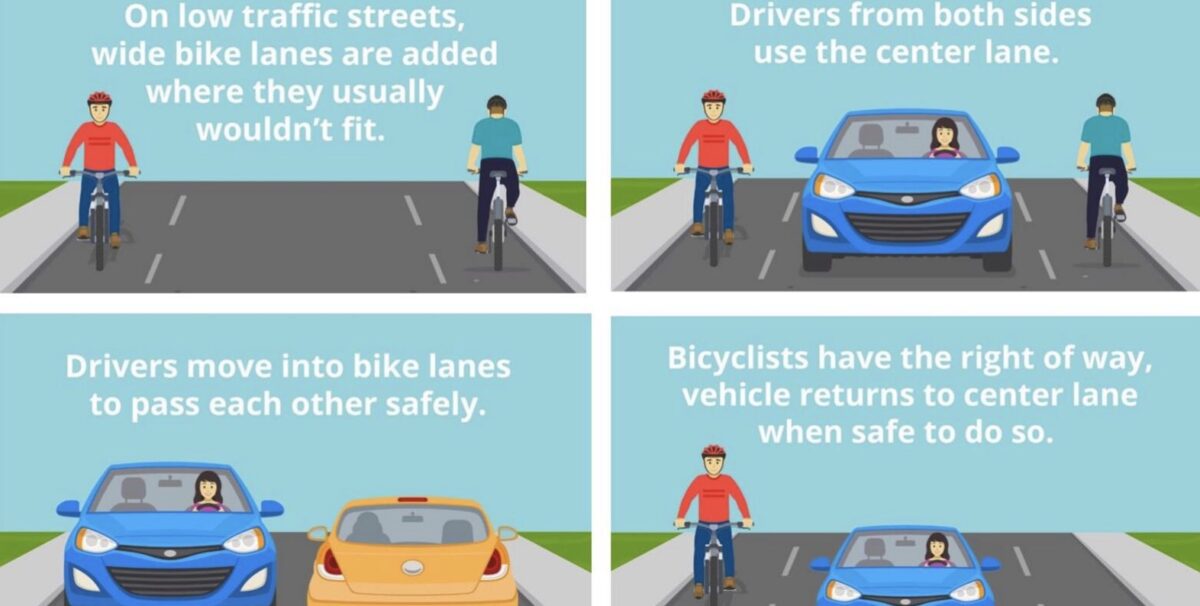
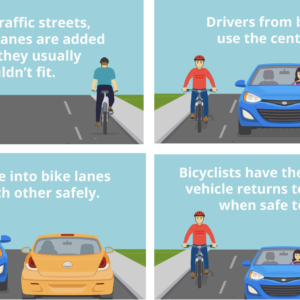

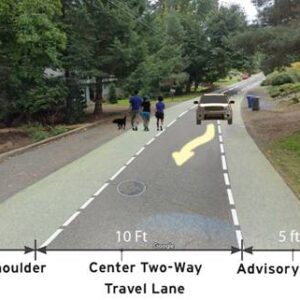
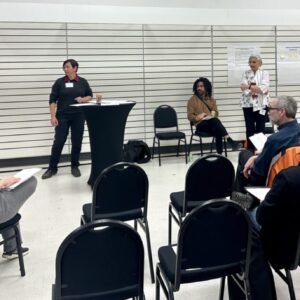
Thanks for reading.
BikePortland has served this community with independent community journalism since 2005. We rely on subscriptions from readers like you to survive. Your financial support is vital in keeping this valuable resource alive and well.
Please subscribe today to strengthen and expand our work.
The people in my Nextdoor feed talking about them on San Rafael were pretty funny. It’s not like this configuration isn’t something they deal with already many of them every day. I mean they’re fine with driving down the middle when there are cars parked on either side of the road but if they have to share that space with a different vehicle type or pedestrian suddenly it’s dangerous and a waste.
Every time they add some new infrastructure to the East Portland it’s the same actors going on about wasted resources and dangerous confusing designs. I really don’t get what people thought PBOT would do when they asked for investment in their neighborhood. I’ve said this before, but PBOT needs better messaging to inform people that generally speaking safer = slower and less space for driving. That being said whenever they do suggest that people don’t want the safety upgrades. Didn’t the 122nd redesign survey pretty much confirm that?
As long as they don’t try to preserve onstreet parking alongside these advisory lanes it will be fine. If there is onstreet parking, then there is room for proper bike infra.
I wonder if there would be any considerations for just removing paint all together. I recall Jeff Speck talking at one point how if a street is low enough traffic, removing road strippings has a safety and traffic calming effect. Some of the low traffic streets around me in SW probably has just as many people walking as there is cars, yet there are no sidewalks and the road is stripped for 2 way car traffic without a shoulder.
53rd at the bridge had no paint before (just a few random sharrows) and it wasn’t great. People didn’t know how to pass safely, and both cyclists and cars ended up positioned all over the ROW. San Rafael west of 122nd was the same way. No striping, but people would still pass me with just inches to spare… the new config is much better.
On 43rd PBOT preserved two parking lanes and removed two bike lanes. It seems to me that advisory bike lanes give PBOT a way to avoid fixing door zone bike lanes by converting them into ambiguous striped lines.
It doesn’t really matter if they work or not in other places. They don’t feel safe. Just more bad car first infrastructure from PBOT
If they expect motorists to grok this or any other experimental treatment solely by osmosis, PBOT still hasn’t learned the lesson that engineering changes alone will not change driver behavior, there needs to be a parallel motorist reeducation effort.
grok lol. I’m reading that book right now.
I think you’re onto something here, FDUP. How many times have you been cycling on a street with two traffic lanes, no shoulder or bike lane, and some driver passes you and goes into the OPPOSING travel lane when there’s a car coming – and the driver of that opposing car lays on his horn? It happens to me a couple of times a week. So many drivers just do NOT KNOW how to pass bicycles safely. It isn’t taught anywhere – my own kids took driver ed and the only time they encountered safe passing of a bicycle was in the textbook and maybe by chance during one of their drive-around sessions.
What most motorists don’t grok when overtaking a cyclist is that the lead vehicle – in this case the cyclist – has the right of way and it is the overtaking driver’s responsibility to slow down, follow at a safe distance and pass the cyclist only when it is safe to do so. This is such a basic rule of the road it always blows my mind when I realize that 90+% of motorists don’t understand the basics of safe operation of their vehicle in the public ROW when confronted with a cyclist in the lane in front of them.
I really dislike the lanes on the 50s bikeway, not only do they not feel safe on a bike, I think that they normalize cars driving in bike areas.
Biking southbound in the bike area creates a dangerous situation where you have people overtaking on your left, while you also have cars pulling out of Hoyt(?) that get super far into the intersection because of limited sight lines. This causes me to take the lane and now that there’s this big wide area in the middle it’s a bit of a free for all with cars.
There’s also the expectation from motorists that you a bike rider stay in the designated bike area, which in this case is now an unsafe place to be. I’ve had enough bad interactions with drivers over the years that it causes me significant stress and anxiety to the point of visibly shaking when people start yelling and honking at me, so I’m really not looking forward to future bad interactions in areas like this.
Photo caption should read 53rd, not 52nd.
As someone who rides 53rd and San Rafael, I think that both are welcome improvements. I have had so many close/unsafe passes on San Rafael in previous years, and it hasn’t been an issue since the restriping was done.
Motorists might be uncomfortable with the lane configurations, but that is usually a good thing.
Personally, I think advisory bike lanes are a fine tool when used appropriately. I don’t really know what PBOT needs to do differently do ‘educate’ people on how to use them. They put up signs in the neighborhood, sent out flyers, now they’re doing an open house. Maybe put up some billboards? Social media ads? A Christmas special about a driver who gets the gift of finally learning how to use their brakes to slow down and assess road conditions (I kid). It’s not that hard to go into google and type “dashed bike lanes how to use”. When ODOT builds a funky freeway ramp configuration do they hold everyone’s hand on how to use it? No, they put up signs and paint and people manage to figure it out.
Folks always act like the sky is falling whenever advisory go in. They didn’t really care about the safety of cyclists before, but now that these scary new bike lanes went in suddenly they’re very concerned that someone is going to get hurt.
In my opinion, PBOT should keep striping advisory bike lanes where appropriate. Might be a bit of pushback but after a year or two everyone will figure out how to use them and get over themselves.
Case in point: they are about to build a diverging diamond in Aurora:
https://www.oregon.gov/odot/projects/pages/project-details.aspx?project=19062
Going to be a surprise when people around here encounter that for the first time.
So… we spend decades(?) Telling motorists to “stay out of the bike lane” & they still seem incapable. Now… “use the bike lane if you need to”? Wtf. Ugh
I can’t agree with this anymore than is humanly possible. As things are, here in Reno, NV, we have a mix of solid lines and dashed line portions of a bike lane allowing cars to cross to access some right turn lanes. Guess what happens at intersections with solid white bike lane lines and cars that line up in the right traffic lane, but someone 2 cars back (or more) wants to turn right?
Just like USPS : if they fits, they make their own personal right turn lane!
It seems like PBOT’s strategy of late is “Do as many cheap projects as possible”.
It’s an obvious effect of Hardesty campaigning for reelection, and a great example of why politicians shouldn’t run city agencies.
Although there’s nothing wrong with picking low hanging fruit, small improvements don’t convince people to bike. Fully separated infrastructure is the only thing that significantly increases riders and reduces car/bike accidents to acceptable levels.
These larger projects don’t wrap up nicely in time for an election, and require a perpetual commitment to their maintenance. Hopefully our future city manager will be more free to develop a robust long term plan.
Why hang this on Hardesty, that’s not clear to me at all. If I were in her shoes I’d be more likely to throw down concrete than paint (and I don’t like concrete).
To me this looks like a bureau with no political will, still twisting in the wind. Maybe lawsuits will graft in a little bit of spine?
A city manager is going to be shopping all over for consensus, what makes a person think they will fort up on the hill of bike infrastructure? Hill 4031 if I’m not mistaken.
PBOT’s M.O. for the last decade or more has been to do bike projects as cheaply as possible with as little inconvenience to motorists as possible. I don’t really see a decline in project quality..
Im guessing that there is pressure to make streets safer from outside the agency due to the massive body count that PBOT and ODOT are racking up and PBOT’s leadership is fighting safety projects by only green-lighting low quality projects.
Those poor folks out there can’t get a break from these idiotic PBOT projects. They can’t even be consistent on speed bump design on a single street like Sacramento. And the “advisory” bike lane on San Rafael is a joke. Nobody out there wants this junk. It’s PBOT telling the poor east side folks how it’s gonna be, because they know best.
If you live in east Portland, or anywhere in Portland for that matter, you can just drive the way you want to, and you will never face consequences. Go ahead and ignore these advisory bike lanes. No one cares enough to do anything about it.
Advisory bike lanes have probably the highest benefit/cost ratio of any investment in bicycling… and traffic-calming. If you’re among the many who think we need to turn to the Netherlands for examples of good bicycling infrastructure, we’ll, guess what… they’re more common there than separated bike paths! If your response is something like “Well, Dutch drivers are used to them,” remember that the Netherlands had to go through opposition from drivers too every time a new scheme that restricts driving space was introduced.
Michael Ronkin, former ODOT Bicycle and Pedestrian Program Manager, who introduced the idea in Oregon well before 2009.
People commonly talk about the Netherlands. I wonder how many people are getting killed walking, riding, and scooting there. Here, in the US and specifically Portland, the numbers are out of control. I’m not sure as a cyclists that I would like to play roulette with my body in the hopes that cars can play nice. They inherently don’t. I think a better solution is to come up with more one way streets and add the bike lanes. Portland has so few one way streets so we are ripe for more. As far as advisory walkways like I have seen in the past, I would never use those to walk on. Neither would my 4 year old.
Thank you for sharing your decades of experience Michael! If the designs get speed under control I’d expect to see real safety improvements—and a lot more biking and walking. PBOT’s new Pedestrian Design Guide is leading the way on these options. Now we just need strong support from the City Traffic Engineer. To visualize, compare what you see on pages 44 and 45 to current conditions on typical streets in East Portland or SW:
https://www.portland.gov/sites/default/files/2022/PBOT%20Pedestrian%20Design%20Guide%202022.pdf
I’ve ridden all three in Portland (43rd, 53rd and San Rafael). I liked them all and consider them an improvement on previous conditions. Can now be in a bike lane on 43rd and out of the door zone. Cars on San Rafael, especially, seem a lot slower than they used to be. Could be confirmation bias. Looking forward to any data produced.
43rd by Whole Foods was pretty chaotic before advisory striping. Haven’t felt like it’s much of an improvement.. do feel like I now see cars who don’t get the point and almost have head on crashes with other cars.
advisory bike lanes (AKA edge lane roads) are an improvement over 2-lane roads because they get VRUs out of the vehicle travel lanes.
they are often opposed by those wanting protected facilities everywhere when that just isn’t going to happen as soon as people want.
don’t let the idea of “perfect” sabotage “better”.
the one thing Portland needs to do is mark buffers between the parking lane and the edge lanes to increase distance between cyclists and parked cars. this will help the comfort and safety of those installations.
(I’ve been told that repeated use of goddamn isn’t good style and will land me in hell so all those are cut out)
Motor vehicle operators are already responsible to give regard and a good amount of space to bike riders, horses, tractors and humans that were in the road before they came along. If people had some instruction before handling their new or renewed license they would know this. If the state gave a stringent test before issuing the license the state would know they knew. If any motor vehicle used to willfully or carelessly harm another human was put into a big press and crushed into a nugget then MVO would get the point pretty fast.
Advisory bike lanes have about the same function as the nipples that come with a boar hog.
(I’m still going to hell)
Thumb up for style. But I’m glad PBOT is moving forward with the advisory lanes, they might be very helpful in SW, the area of town with the narrowest road widths.
Think if there isn’t room for bike infrastructure and two way car traffic then the real solution is to add proper protected bike infrastructure and make the road one way for cars.